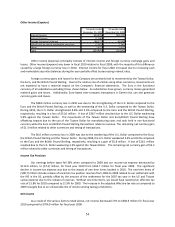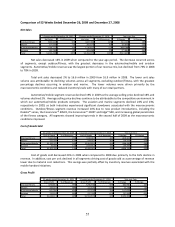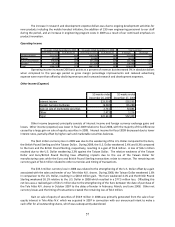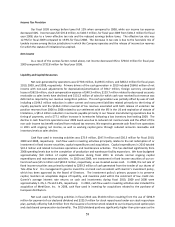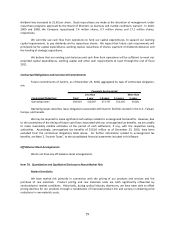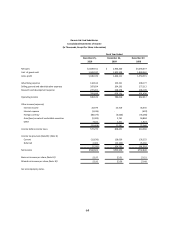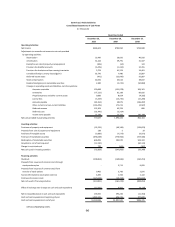Garmin 2010 Annual Report Download - page 70
Download and view the complete annual report
Please find page 70 of the 2010 Garmin annual report below. You can navigate through the pages in the report by either clicking on the pages listed below, or by using the keyword search tool below to find specific information within the annual report.60
Inflation
We do not believe that inflation has had a material effect on our business, financial condition or results of
operations. If our costs were to become subject to significant inflationary pressures, we may not be able to fully
offset such higher costs through price increases. Our inability or failure to do so could adversely affect our
business, financial condition and results of operations.
Foreign Currency Exchange Rate Risk
The opeatio of Gais susidiaies i iteatioal akets esults i eposue to oeets i
currency exchange rates. We have experienced significant foreign currency gains and losses due to the
strengthening and weakening of the U.S. dollar. The potential of volatile foreign exchange rate fluctuations in the
future could have a significant effect on our results of operations.
The ueies that eate a ajoit of the Copas ehage ate eposure are the Taiwan Dollar,
Euro, and British Pound Sterling. Garmin Corporation, headquartered in Sijhih, Taiwan, uses the local currency as
the functional currency. The Company translates all assets and liabilities at year-end exchange rates and income
and expense accounts at average rates during the year. In order to minimize the effect of the currency exchange
flutuatios o ou et assets, e hae eleted to etai ost of ou Taia susidias ash ad iestets i
marketable securities denominated in U.S. dollars.
All European subsidiaries excluding Garmin (Europe) Ltd., Garmin Danmark, Garmin Sweden, Garmin
Polska and Garmin Norge use the Euro as the functional currency. The functional currency of our largest European
subsidiary, Garmin (Europe) Ltd. remains the U.S. dollar, and as some transactions occurred in British Pounds
Sterling or Euros, foreign currency gains or losses have been realized historically related to the movements of
those currencies relative to the U.S. dollar. The Company believes that gains and losses will become more material
in the future as our European presence grows. In 2010, the U.S. Dollar strengthened 8.8% relative to the Euro and
3.3% relative to the British Pound Sterling. These currency moves resulted in a foreign currency loss of $51.0
million in Garmin Ltd. and our European subsidiaries. A loss of $38.7 million resulted due to the U.S. Dollar
weakening 5.9% against the Taiwan Dollar. The net result of these currency moves combined with other gains of
$1.3 million, and the timing of transactions during the year was a net loss of $88.4 million for the Company and a
cumulative translation adjustment of $61.7 million at the end of fiscal 2010.
Interest Rate Risk
We have no outstanding long-term debt as of December 25, 2010. We, therefore, have no meaningful
debt-related interest rate risk.
We are exposed to interest rate risk in connection with our investments in marketable securities. As
interest rates change, the unrealized gains and losses associated with those securities will fluctuate accordingly. A
hypothetical change of 10% in interest rates would not have a material effect on such unrealized gains or losses.
At December 25, 2010, cumulative unrealized losses on those securities were $4.6 million.






